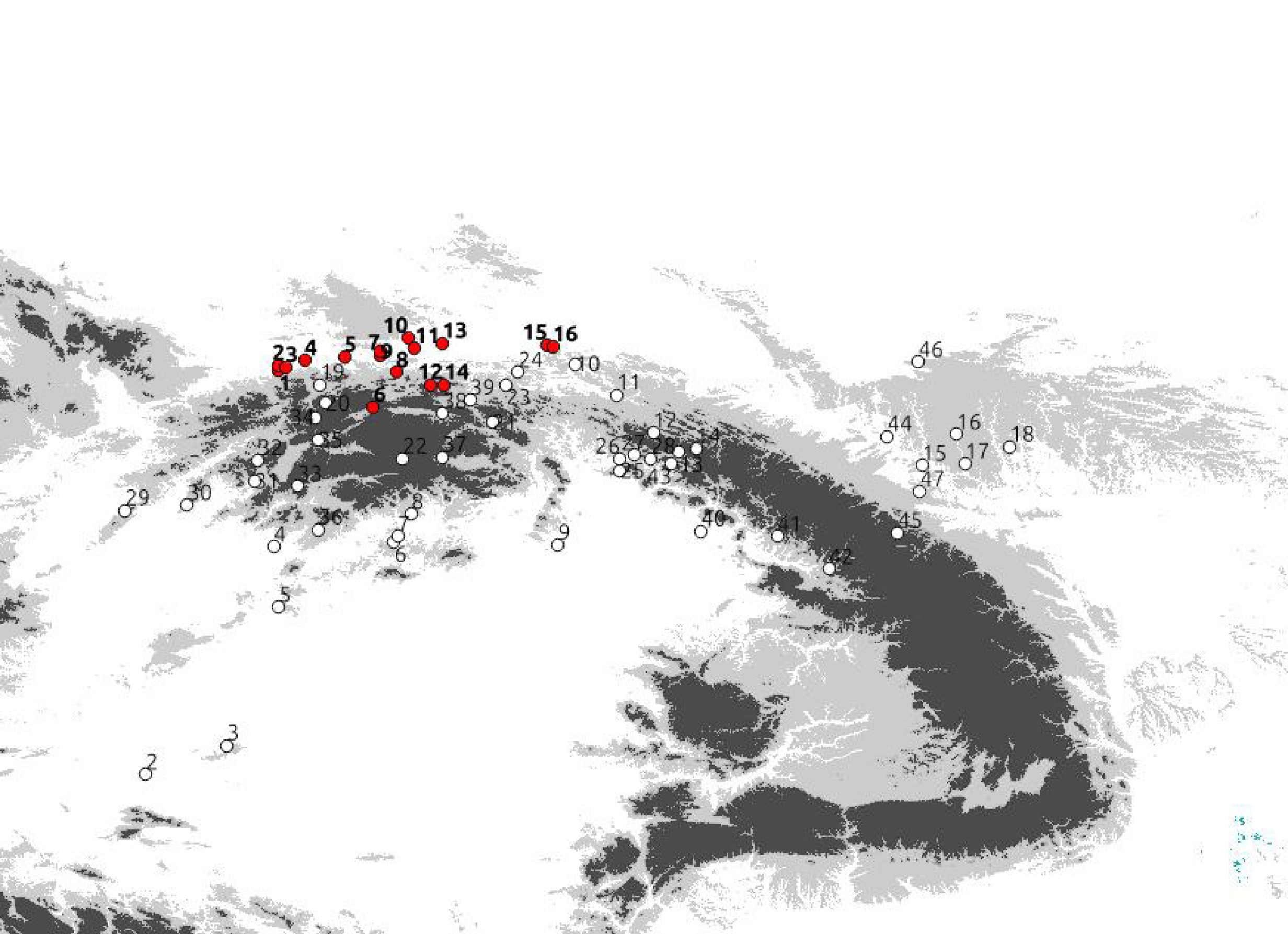Putative forest glacial refugia in the Western and Eastern Carpathians
Abstract
An examination of thermophilous species pollen deposits found in the Plenivistulian river alluvial terraces in the Polish Western Carpathians was conducted. Of the 16 palaeobotanical sites evaluated, most often noted were Alnus and Betula t. alba; Abies, Carpinus and Corylus occurred less frequently, and Quercus, Tilia and Ulmus were rare. Fagus and Fraxinus pollen were absent. Abies and Carpinus were relatively overrepresented, because their frequency of occurrence was similar to Corylus avellana, i.e. one of the most cold-resistant species. Based on a literature survey of phylogeographic studies and data regarding the forest species Aconitum moldavicum, A. variegatum, Bromus benekenii, Carpinus betulus, Lathyrus vernus, Lonicera nigra, and the moderately thermophilous Rosa pendulina, 47 cryptic refugial areas of temperate plant species are postulated. The combined analysis indicates that they could have survived the last glaciation in the W & E Carpathian microrefugia close to 650 m a.s.l., and in Podolia (north of the Eastern Carpathians) along a contour of 300 m a.s.l.
References
Bhagwat S.A., Willis K.J. 2008. Species persistence in northerly glacial refugia of Europe: a matter of chance or biogeographical traits. J. Biogeogr. 35: 464–482.
Brewer S., Cheddadi R., Beaulieu M., Reille M. et al. 2002. The spread of deciduous Quercus throughout Europe since the last glacial period. Forest Ecol. Manage. 156: 27–48.
Daneck H., Abraham V., Fér T., Marhold K. 2011. Phylogeography of Lonicera nigra in Central Europe inferred from molecular and pollen evidence. Preslia 83: 237–257.
Fér T., Vasak J., Marhold K. 2007. Out of the Carpathians? Origin of Central European populations of Rosa pendulina. Preslia 79: 367–376.
Gębica P. 2004. Przebieg akumulacji rzecznej w górnym Vistulianie w Kotlinie Sandomierskiej. Prace Geograficzne 193: 1–229.
Gębica P., Szczepanek K., Pazdur A., Sańko A.F. 1998. Vistulian terrace with loess cover in the Vistula river valley near Nowe Brzesko (Southern Poland). Biuletyn Peryglacjalny 37: 81–93.
Gilot E., Niedziałkowska E., Sobolewska M., Starkel L. 1982. Pleniglacial alluvial fan of the Biała stream at Kaniów near Czechowice (the Oświęcim Basin). Studia Geomorphologica Carpatho-Balcanica 15: 115–124.
Hajnalová M., Hajnalová E. 2005. The plant macro-remains: the environment and plant foods exploited by hunter-gatherers. In: Kaminská L’., Kozłowski J., Svoboda J.A. (eds), Pleistocene environments and archaeology of Dzeravá skala Cave, Lesser Carpathians, Slovakia: 91–135. PAU, Kraków.
Ilnicki T., Joachimiak A.J., Sutkowska A., Mitka J. 2011. Cytotypes distribution of Aconitum variegatum L. in Central Europe. In: Zemanek B. (ed.), Geobotanist and taxonomist. A volume dedicated to Professor Adam Zając on the 70th anniversary of his birth: 169–192. Institute of Botany, Jagiellonian University, Cracow.
Jasiewiczowa M. 1980. Late-Glacial and Holocene vegetation of the Bieszczady Mts. (Polish eastern Carpathians). Państwowe Wydawnictwo Naukowe, Warszawa.
Koperowa W., Środoń A. 1965. Pleniglacial deposits of the Last Glaciation at Zator (West of Kraków). Acta Palaeobot. 6: 3–31.
Kowalkowski A., Starkel L. 1984. Altitudinal belts of geomorphic processes in the Southern Khangai Mts. (Mongolia). Studia Geomorphologica Carpatho-Balcanica 18: 95–115.
Mamakowa K. 2003. Plejstocen. In: Dybova‑Jachowicz S., Sadowska A. (eds), Palinologia: 235–266. Instytut Botaniki im. W. Szafera, PAN, Kraków.
Mamakowa K., Rutkowski J. 1989. Wstępne wyniki badań litologicznych i paleobotanicznych profilu z Kryspinowa. Przewodnik 60 Zjazdu Pol. Tow. Geol., Kraków: 117–124.
Mamakowa K., Starkel L. 1974. New data about the profile of Young Quaternary deposits at Brzeźnica on the Wisłoka River. Studia Geomorphologica Carpatho-Balcanica 8: 47–59.
Mamakowa K., Starkel L., Boratyn J., Brud S. 1997. Stratigraphy of the Vistulian alluvia fills in the Wisłoka valley north of Dębica. Studia Geomorphologica Carpatho-Balcanica 31: 83–99.
Mamakowa K., Środoń A. 1977. On the pleniglacial flora from Nowa Huta and Quaternary deposits of the Vistula valley near Cracow. Rocznik Pol. Tow. Geolog. 77: 485–511. (in Polish with English summary)
Mitka J., Bąba W., Boroń P., Bizan J., Wróblewska A., Szczepanek K. In revision. AFLP fingerprinting points to genetic melting pots and glacial refugia of Carpinus betulus in central Europe.
Mitka J., Boroń P., Sutkowska A. 2013. Holocene history of Aconitum in the Polish Western Carpathians: long-distance migrations or cryptic refugia? Mod. Phytomorphol. 3: 9–18.
Niedziałkowska E., Gilot E., Pazdur M.F., Szczepanek K. 1985. The upper Vistula Valley near Drogomyśl in the late Vistulian and Holocene. Folia Quaternaria 56: 101–132.
Niedziałkowska E., Szczepanek K. 1993-1994. Utwory pyłowe vistuliańskiego stożka Wisły w Kotlinie Oświęcimskiej. Studia Geomorphologica Carpatho-Balcanica 27–28: 29–44. (in Polish with English summary)
Ronikier M. 2011. Biogeography of high-mountain plants in the Carpathians: an emerging phylogeographical perspective. Taxon 60: 373–389.
Schiemann K., Tyler T., Widén B. 2000. Allozyme diversity in relation to geographic distribution and population size in Lathyrus vernus (L.) Bernh. (Fabaceae). Plant Syst. Evol. 225: 119–132.
Starkel L. 1988. Palaeography of the periglacial zone in Poland during the maximum of advance of the Vistulian sheet. Geographia Polonica 55: 151–163.
Stewart J.R., Lister A.M. 2001. Cryptic northern refugia and the origins of modern biota. Trends Ecol. Evol. 16: 608–613.
Sutkowska A., Pasierbiński A., Warzecha T., Mitka J. 2014. Multiple cryptic refugia of forest grass Bromus benekenii in Europe as revealed by ISSR fingerprinting and species distribution modeling. Plant Syst. Evol. doi: 10.1007/s00606-013-0972-x
Środoń A. 1968. On the vegetation of the Paudorf interstadial (last glaciation) in the Western Carpathians. Acta Paleobot. 9: 3–37. (in Polish with English summary)
Środoń A. 1987. A communication on the locality of the periglacial flora at Sadowie in the Miechów Upland (Vistulian, Southern Poland). Acta Paleobot. 27: 71–75.
Willis K., van Andel T.H. 2004. Trees or no trees? The environments of central and eastern Europe during the Last Glaciation. Quaternary Science Reviews 23: 2369–2387.


This work is licensed under a Creative Commons Attribution-NonCommercial-NoDerivatives 4.0 International License.
The journal is licensed by Creative Commons under BY-NC-ND license. You are welcome and free to share (copy and redistribute the material in any medium or format) all the published materials. You may not use the material for commercial purposes. You must give appropriate credit to all published materials.
The journal allow the author(s) to hold the copyrights and to retain publishing rights without any restrictions. This is also indicated at the bottom of each article.





